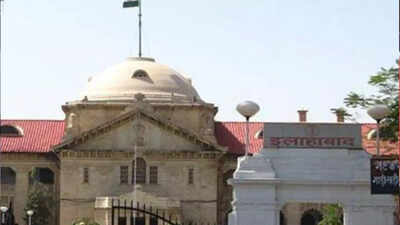- News
- City News
- allahabad News
- Will scientific probe damage Gyanvapi ‘shivling’? Allahabad HC asks ASI
Will scientific probe damage Gyanvapi ‘shivling’? Allahabad HC asks ASI

Allahabad high court. (File image)
PRAYAGRAJ: The Allahabad high court on Friday asked the director general of Archaeological Survey of India to clarify if the carbon dating and similar scientific investigation of the purported 'shivling' found in the wuzu pond of the Gyanvapi complex during a recent court-mandated survey can cause damage to the structure in any way.
The HC has asked the ASI to respond to this specific question in an order that was issued on Friday while hearing a petition challenging the Varanasi district judge's recent order that rejected carbon dating and scientific investigation of the ‘shivling’.
The bench of Justice JJ Munir sought the response of the ASI while admitting a petition challenging the Varanasi court's order that rejected the demand for carbon dating and scientific investigation of the purported ‘shivling’ found during a court-mandated survey of Gyanvapi premises on May 16.
The court further directed the director general of ASI to submit her opinion whether investigation of the said structure, if examined through carbon dating, ground- penetrating radar (GPR), excavation and other methods adopted to determine its age, nature and other relevant information, was likely to damage it, or a safe evaluation about its age can be done.
Hearing a civil revision petition by Laxmi Devi and three others, Justice JJ Munir directed that the said report be submitted by the DG ASI by November 21, the next date for the hearing of the matter. The court also directed that this order be communicated to the DG ASI by the registrar (compliance) of the high court within 24 hours.
In view of the assertion made by Hari Shankar Jain, the counsel for the petitioner, that the district judge, Varanasi was proceeding with the suit and that may affect adversely the outcome of any possible scientific investigation by the ASI, the court directed that the district judge, Varanasi should fix a date in the suit in the first week of December.
In addition to it, the court admitted the petition and also issued notices to Anjuman Intezamia Masajid — the management committee of Gyanvapi mosque — the state government, district administration and other respondents in the case.
Earlier, the five Hindu women petitioners had approached the civil court of Varanasi, seeking the right to worship Shringar Gauri and other deities inside Gyanvapi mosque.
Acting on their application, the civil court ordered a survey of Gyanvapi mosque by the advocate commissioner, who then videotaped the premises and submitted a report to the court. The report, among other findings, stated that an object resembling a ‘shivling’ was found on May 16.
The AIM challenged the survey in the Supreme Court which directed the Varanasi district judge to hear the case. Thereafter, four out of five petitioners moved an application before the district judge seeking appointment of experts of ASI to find out the age and nature of the purported ‘shivling’.
The district judge, Varanasi, on October 14 rejected the demand of carbon dating as well as scientific investigation primarily on the ground that the finding by the advocate commissioner, which the plaintiffs claim to be a ‘shivling’, is required to be protected in terms of the Supreme Court’s order dated May 20, 2022. "The scientific examination sought may damage it," added the district judge in his order dated October 14.
Hence, the petitioners challenged the October order of the district judge before the high court on the ground that he wrongly presumed that a scientific investigation in the form of carbon-dating or the ground-penetrating radar (GPR) would harm or damage the object.
The counsel for the petitioner took the plea that the “order of the district judge is bad in law because it is based on a reasoning that a scientific investigation of the ‘shivling’, claimed by the plaintiffs, would lead to its damage and that would violate the Supreme Court’s order". They urged that there was no basis to this apprehension because whether the carbon-dating, ground-penetrating radar (GPR) and excavation would indeed damage it, can only be judged based upon the opinion by the ASI and not by assumption or conjecture.
Underlining that one of the opposite parties described the object as a fountain, the plea alleged that the district judge wrongly held that the question involved in the suit did not require ASI investigation and stated that a scientific investigation was necessary to ensure proper adjudication of controversy.
The HC has asked the ASI to respond to this specific question in an order that was issued on Friday while hearing a petition challenging the Varanasi district judge's recent order that rejected carbon dating and scientific investigation of the ‘shivling’.
The bench of Justice JJ Munir sought the response of the ASI while admitting a petition challenging the Varanasi court's order that rejected the demand for carbon dating and scientific investigation of the purported ‘shivling’ found during a court-mandated survey of Gyanvapi premises on May 16.
The court further directed the director general of ASI to submit her opinion whether investigation of the said structure, if examined through carbon dating, ground- penetrating radar (GPR), excavation and other methods adopted to determine its age, nature and other relevant information, was likely to damage it, or a safe evaluation about its age can be done.
Hearing a civil revision petition by Laxmi Devi and three others, Justice JJ Munir directed that the said report be submitted by the DG ASI by November 21, the next date for the hearing of the matter. The court also directed that this order be communicated to the DG ASI by the registrar (compliance) of the high court within 24 hours.
In view of the assertion made by Hari Shankar Jain, the counsel for the petitioner, that the district judge, Varanasi was proceeding with the suit and that may affect adversely the outcome of any possible scientific investigation by the ASI, the court directed that the district judge, Varanasi should fix a date in the suit in the first week of December.
In addition to it, the court admitted the petition and also issued notices to Anjuman Intezamia Masajid — the management committee of Gyanvapi mosque — the state government, district administration and other respondents in the case.
Earlier, the five Hindu women petitioners had approached the civil court of Varanasi, seeking the right to worship Shringar Gauri and other deities inside Gyanvapi mosque.
Acting on their application, the civil court ordered a survey of Gyanvapi mosque by the advocate commissioner, who then videotaped the premises and submitted a report to the court. The report, among other findings, stated that an object resembling a ‘shivling’ was found on May 16.
The AIM challenged the survey in the Supreme Court which directed the Varanasi district judge to hear the case. Thereafter, four out of five petitioners moved an application before the district judge seeking appointment of experts of ASI to find out the age and nature of the purported ‘shivling’.
The district judge, Varanasi, on October 14 rejected the demand of carbon dating as well as scientific investigation primarily on the ground that the finding by the advocate commissioner, which the plaintiffs claim to be a ‘shivling’, is required to be protected in terms of the Supreme Court’s order dated May 20, 2022. "The scientific examination sought may damage it," added the district judge in his order dated October 14.
Hence, the petitioners challenged the October order of the district judge before the high court on the ground that he wrongly presumed that a scientific investigation in the form of carbon-dating or the ground-penetrating radar (GPR) would harm or damage the object.
The counsel for the petitioner took the plea that the “order of the district judge is bad in law because it is based on a reasoning that a scientific investigation of the ‘shivling’, claimed by the plaintiffs, would lead to its damage and that would violate the Supreme Court’s order". They urged that there was no basis to this apprehension because whether the carbon-dating, ground-penetrating radar (GPR) and excavation would indeed damage it, can only be judged based upon the opinion by the ASI and not by assumption or conjecture.
Underlining that one of the opposite parties described the object as a fountain, the plea alleged that the district judge wrongly held that the question involved in the suit did not require ASI investigation and stated that a scientific investigation was necessary to ensure proper adjudication of controversy.
FOLLOW US ON SOCIAL MEDIA
FacebookTwitterInstagramKOO APPYOUTUBE
Start a Conversation
end of article









